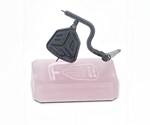Coronavirus Emergency: Ventilator Valves 3D Printed at Hospital
Valves in short supply made in hours with FDM and SLS printers. New heat-resistant material shows promise.
Responding to an urgent need for ventilator valves in the Italian city of Brescia, several organizations jumped into action to fill the gap by 3D printing the valves on the spot at the hospital where they were in short supply.

In March, the hospital found that it was short of the critical venturi valves that regulate oxygen flow in ventilators, and the OEM supplier could not provide more on time. Isinnova, an independent research institute in Rome, transported its FDM-type 3D printer to the hospital, and reverse-engineered, prototyped and printed 100 valves over a single weekend.
According to representatives of 3D Systems, supplier of 3D printing machines and materials, one of its customers in Brescia, a maker of sock-knitting machines called Lonati, followed up by bringing its 3D Systems SLS printer to the same hospital and made additional parts in medical-grade nylon that reportedly were more functional and water-tight.
3D Systems also prototyped the valves using its new M2S-HT90 MultiJet printing material. This acrylic-based, UV-cured resin has the advantage of elevated heat resistance (HDT around 90 C/194 F), reportedly allowing it to be autoclave sterilized. 3D Systems also says this biocompatible (USP Class VI) material lends itself to production of internal flow chambers and voids, due to the ease of removal of its wax support material. 3D Systems printed 88 valves in this new material in 29 hr and removed the supports in <2 hr of post-processing.

3D Systems says a model of this valve is available for free from GrabCAD member Filip Kober of Poland. However, the case reported above was an emergency, and 3D Systems recommends that in less urgent circumstances, potential parts providers should follow these precautions: (1) use USP Class VI/ISO 10993 certified materials; (2) print parts in an ISO-certified facility, whether a hospital or service provider; and (3) work with a clinical partner to validate the device and process.
Related Content
-
Allegheny Performance Plastics to Enter Health Care Sector
The custom molder has secured multiple projects in health care and will be adding cleanroom and white-room spaces, as well as injection molding machines, in support.
-
Plastic Compounding Market to Outpace Metal & Alloy Market Growth
Study shows the plastic compounding process is being used to boost electrical properties and UV resistance while custom compounding is increasingly being used to achieve high-performance in plastic-based goods.
-
Use Cavity Pressure Measurement to Simplify GMP-Compliant Medical Molding
Cavity-pressure monitoring describes precisely what’s taking place inside the mold, providing a transparent view of the conditions under which a part is created and ensuring conformance with GMP and ISO 13485 in medical injection molding.
















